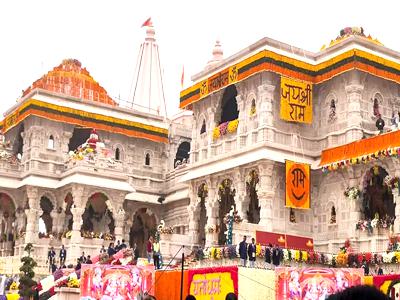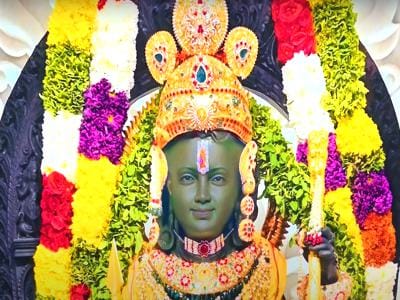Ram Mandir

Ayodhya Ram Mandir
Ayodhya, located in Uttar Pradesh, India, is now home to the magnificent Ayodhya Ram Mandir, a sacred temple dedicated to Lord Ram. This grand temple has become a symbol of faith, unity, and Indian heritage. The Ayodhya Ram Mandir murti (idol) of Shri Ram Lalla is carved from divine black stone, reflecting immense spiritual energy and devotion. The temple architecture showcases ancient Indian craftsmanship and Vastu traditions, attracting millions of devotees and tourists from across the globe.
The Ayodhya Ram Mandir, located in the holy city of Ayodhya in Uttar Pradesh, is a magnificent temple dedicated to Lord Rama, highly revered in Hinduism. Situated on the banks of the Sarayu River, a sacred waterway mentioned in ancient scriptures, the site holds great spiritual significance. Pilgrims often dip in the river before visiting the temple, believing it purifies the soul.
The Ayodhya Ram Mandir timing for darshan is usually from 6:00 AM to 10:00 PM, allowing ample time for pilgrims to offer prayers and experience peace. Visitors are encouraged to check official sources before planning their trip as timings may change on special occasions or festivals.
The temple exhibits intricate architectural designs inspired by traditional Indian temple art. Built from premium Rajasthani sandstone, the Ayodhya Ram Mandir features detailed carvings, a towering spire and a sanctum sanctorum that houses the divine idol of Lord Rama. The temple complex also includes other temples dedicated to major characters of the Ramayana, which add to its spiritual essence.
The Ayodhya Ram Mandir history dates back thousands of years, believed to be the birthplace of Lord Ram. The temple’s reconstruction marks a historic moment following decades of cultural and legal developments. Today, it stands as a majestic blend of devotion and architecture.
Pilgrims and tourists visit the Ayodhya Ram Temple to seek blessings, meditate and experience its serene and divine atmosphere. The temple’s well-maintained gardens, spacious pathways and visitor facilities ensure a comfortable and enriching experience.
Visiting during festivals like Ram Navami enhances the spiritual journey as Ayodhya turns into the centre of celebrations. Ayodhya Ram Mandir is a symbol of faith and unity, reflecting India’s eternal devotion and rich religious history.



Festivals Celebrated at Ram Mandir

Diwali: Ram Mandir celebrates Diwali with great enthusiasm, marking the return of Lord Ram to Ayodhya. Devotees light lamps, decorate the temple, and offer prayers for prosperity and happiness.
Ram Navami: The birth of Lord Ram is celebrated with devotion and joy. Special prayers, bhajans, and cultural programs are organized, and devotees gather to honor Lord Ram.
Ramotsav: This annual festival celebrates Lord Ram’s life and teachings with grand processions, devotional music, and prayers, drawing large crowds of devotees seeking blessings.
Guidelines for Visiting Ayodhya Ram Mandir
General Behavior:
- Dress modestly, respecting the sanctity of the temple. Avoid wearing shorts, sleeveless tops, or revealing attire.
- Maintain silence and decorum inside the temple premises. Loud conversations and disruptions are discouraged.
Security Measures:
- Be prepared for a thorough security check at the entrance. Arrive early to allow sufficient time for this process.
- Carry a valid ID proof for verification purposes.
Darshan Timings:
- General Darshan: Open daily from 6:00 AM to 10:00 PM.
- Special Aartis:
- Mangala Aarti: 4:00 AM
- Shringar Aarti: 6:30 AM to 11:50 AM
- Bhog Aarti: Noon
- Sandhya Aarti: Evening till 9:45 PM
- Shayan Aarti: 10:00 PM
Entry Passes:
- General Darshan: No entry pass required.
- Special Aartis: Entry requires a pass, obtainable free of charge from the Shri Ram Janmabhoomi Teerth Kshetra Trust website.
- Required Information: Name, age, Aadhar card number, mobile number, and city.
Prohibited Items:
- Do not bring flowers, garlands, prasad, mobile phones, purses, or footwear into the temple premises.
Photography and Videography:
- People generally cannot take photographs inside the temple sanctum and near the idols.. However, visitors can take pictures of the temple exterior and surrounding areas, provided it does not disturb the sanctity of the temple. Always look for special guidelines for photography at the entrance.
Facilities:
- Wheelchairs: Available for elderly and differently-abled visitors within the temple premises. A nominal fee is charged for volunteer assistance.
- Drinking Water: Drinking water is available at designated spots within the temple premises.
- Cloakrooms: Store personal belongings like mobile phones, bags, and footwear in cloakrooms, as these are not permitted inside.
Health and Safety:
- If you are visiting during the summer months, stay hydrated and wear sunscreen to avoid sunburn.
- Elderly or physically challenged visitors should take advantage of wheelchairs and shaded rest areas.
Additional Tips:
- The entire darshan process typically takes 60 to 75 minutes.
- There are no provisions for special darshan through paid passes; beware of scams suggesting otherwise.
- For optimal weather, plan visits between October and March.
- Visiting during festivals like Diwali or Ram Navami offers a unique experience but expect larger crowds.
- Weekends and festivals attract large crowds. Plan visits during weekdays or non-peak hours for a more serene experience.
Nearby Attractions:
- Consider visiting nearby sites like Hanuman Garhi Temple, Kanak Bhavan, and Sarayu River Ghats to enrich your trip.
How to Reach Ayodhya From Delhi
1. By Road (Car/Self-Drive)
- Distance: Approximately 670 km
- Travel Time: Around 10-12 hours, depending on traffic and road conditions
- Route: Delhi → Agra → Kanpur → Faizabad → Ayodhya
- Details: Traveling by road offers flexibility and a scenic journey through major highways, including the Yamuna Expressway and NH19. Ensure your vehicle is in good condition, and plan for rest stops along the way.
2. By Bus
- Nearest Bus Stand: Ayodhya Bus Stand
- Travel Time: Around 12-14 hours
- Type of Buses: Sleeper, AC, Non-AC, and Volvo buses are available from Delhi to Ayodhya.
- Route: Delhi → Lucknow → Ayodhya
- Details: Various private and state transport buses operate on this route. It is advisable to book tickets in advance, especially during festive seasons.
3. By Air
- Nearest Airport: Ayodhya International Airport (operational now). Alternatively, Chaudhary Charan Singh International Airport in Lucknow can be used for connecting travel.
- Distance: Approximately 670 km from Delhi to Ayodhya (including flight and road travel).
- Travel Time: 1.5 hours (flight to Ayodhya) or 2 hours (flight to Lucknow) + 3-4 hours (road transfer from Lucknow to Ayodhya).
- Route:
- For Ayodhya Airport: Take a direct flight from Delhi to Ayodhya, followed by a short commute to the city center.
- For Lucknow Airport: Take a flight from Delhi to Lucknow. From Lucknow, travel to Ayodhya by road via NH27, covering 150 km.
- Details: Ayodhya International Airport now offers direct flights, ensuring faster travel. For those using Lucknow as a transit point, frequent flights from Delhi to Lucknow make air travel convenient. Once in Lucknow, travelers can hire a taxi or take a bus to Ayodhya. The NH27 route from Lucknow to Ayodhya ensures a comfortable and scenic journey.
4. By Train
- Nearest Railway: Ayodhya Junction and Faizabad Junction (located around 6 km from Ayodhya)
- Distance: Approximately 670 km
- Travel Time: 8-10 hours, depending on the train service
- Route:
- Trains depart from major Delhi stations such as New Delhi (NDLS), Anand Vihar Terminal (ANVT), or Old Delhi (DLI).
- The train travels through Lucknow and Faizabad before reaching Ayodhya Junction.
- Details: Multiple express and superfast trains, including the Saryu Express, Ayodhya Express, and Vaishno Devi Express, connect Delhi to Ayodhya. Trains are a cost-effective option and offer sleeper and AC coaches for comfort. Booking tickets in advance is recommended, especially during peak travel seasons and festivals. Upon arrival at Ayodhya Junction, the main temple and other attractions are easily accessible via auto-rickshaws or taxis.
🕌 Places to Visit in Ayodhya
1. Ram Janmabhoomi
- The birthplace of Lord Rama, this temple is the most important religious site in Ayodhya. It is a must-visit place for spiritual seekers and those interested in history.
2. Hanuman Garhi
- An iconic temple dedicated to Lord Hanuman, which offers a wonderful view of the city. It is believed that Hanuman protects the city from all kinds of troubles.
3. Kanak Bhawan
- Known for its beautiful architecture, this palace is associated with Goddess Sita and Lord Rama. It is a serene place for tourists looking for peace and divine blessings.
4. Sarayu River
- It is a sacred river where devotees perform rituals and take holy baths. Its ghats provide a picturesque spot for an evening walk.
5. Nageshwarnath Temple
- Kush, the son of Lord Rama, built this temple dedicated to Lord Shiva, and it holds immense historical and religious significance.
6. Treta Ke Thakur
- This temple, which has idols of Lord Rama, Sita, Lakshmana and Hanuman, is believed to have been established during the Treta Yuga.
7. Guptar Ghat
- A serene spot on the banks of River Saryu, it is believed to be the place where Lord Rama took Jal Samadhi.
8. Ram Ki Paidi
- A series of ghats along the banks of River Saryu, it is an ideal place to enjoy the rituals and the peaceful atmosphere of Ayodhya.
9. Chhoti Devkali Temple
- Dedicated to Goddess Sita, this temple is another important place of worship in the city.
10. Ramkot
- Close to Ram Janmabhoomi, the site is located in the heart of Ayodhya and attracts a large number of pilgrims, especially during Ram Navami.
🛏️ Accommodation Options in Ayodhya – Where to Stay
Ayodhya offers a wide range of accommodation options for every type of traveler – from budget pilgrims to luxury seekers. Here’s a quick guide to help you choose the right place to stay during your visit to the Ayodhya Ram Mandir.
🕌 Budget Hotels and Dharamshalas
- If you’re a spiritual traveler or pilgrim looking for an affordable stay:
- Dharamshalas: Run by religious trusts, these provide basic facilities at low costs.
- Budget Hotels: Starting from ₹500 per night, located near Ayodhya Ram Mandir and railway station.
- Popular options: Shri Ram Hotel, Yatri Niwas, Rahi Tourist Bungalow.
🏨 Mid-Range Hotels
- Comfortable and clean stays with modern amenities:
- Ideal for families and small groups.
- Price range: ₹1000–₹3000 per night.
- Recommended: Kohinoor Palace, Ramprastha Hotel, Clarks Inn Express.
🌟 Luxury & Heritage Stays
- For a more premium experience with traditional ambiance:
- Elegant rooms, spiritual vibes, and top-class service.
- Price range: ₹4000 and above.
- Suggested: Hotel Ramayana, Royal Heritage Hotel, The Ramayana Ayodhya (upcoming).
🍛 Local Food and Cuisine in Ayodhya – A Taste of Tradition
Ayodhya is not just a spiritual destination, but also a place where you can enjoy traditional and soulful Indian food. The local cuisine reflects the purity and simplicity of this holy city.
🥘 Popular Vegetarian Dishes
- Since Ayodhya is a religious city, pure vegetarian food is widely available and commonly served.
- Aloo Poori – A classic breakfast dish served with tangy sabzi and pickles.
- Kachori Sabzi – A spicy and crispy delight, perfect for mornings or evening snacks.
- Paneer Curry with Roti – Soft paneer cooked in rich gravy, served with hot tandoori rotis.
🍬 Traditional Sweets
- Ayodhya is famous for its desi sweets, often offered as prasad.
- Rabri – Thickened sweet milk, topped with dry fruits.
- Malpua – Deep-fried pancakes dipped in sugar syrup, a festive favorite.
- Ladoo & Pedha – Commonly offered at temples and sold across local sweet shops.
☕ Street Food Must-Try
- Chai with Mathri or Samosa at roadside stalls.
- Jalebi fresh and hot in the mornings.
